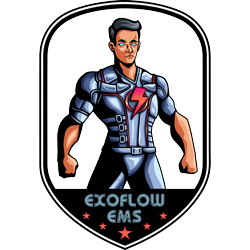How muscles respond to traditional training:
During traditional training sessions, slow-twitch red fibre is used first. It is the most energy efficient means of using muscles and therefore the default for the body. Then as the body is working harder, fast- twitch white fibre is added; this is the “power” fibre which the body calls on when it needs that extra boost. Like any good team, muscles fire their individual fibres in relays, so that some fibres are kept as a reserve for when others are exhausted. These reserve fibres will be predominately white under voluntary contraction. All of these safeguards are naturally biomechanical designed to prevent overloading the central nervous system.
How muscles respond to EMS training:
EMS training, does not follow these same rules and bypasses the CNS. It is designed to work directly on the muscles it is applied to, without the relay effect. Therefore, there is no limit to the amount of fibres that can be activated at once and it does not rely on waiting for the body to require the white fibres, instead it reverses the natural recruitment order. A training stimulus unattainable by any other means. With the correct currents EMS training is able to take muscle fibre activation beyond the natural maximum. This in turn enhances the muscle density by improving the muscle recruitment over the usual cross-sectional growth (or bulking!). EMS training also optimises the splitting process of the muscle fibres and the conversion of intermediate fibres to the fast twitch white fibres. EMS training is an ideal means for improving recruitment velocity across all fibre types, as well as attaining strength gains, especially in explosive events. In short, EMS training equals bigger gains faster.

Strength, Endurance or Recovery
Understanding frequency levels
Understanding what the frequency levels represents will help you understand why we do what we do and why we are so passionate about it. Frequency can determinate which type of muscle fibres are activated during the training session or training cycle. Our frequency manipulation allows us to target 3 aspects of the training realm. Strength, endurance, recovery. So, what exactly is the difference between the 3 training types. Simply put it is the frequency in which the muscle fibres are stimulated. EMS is represented in frequencies below 100hz and tens is represented above 100hz. TENS targets the sensory nerves, while EMS attacks the motor nerve and attempts to recruit as many muscle fibres as possible.
Low frequency stimulation (1-40 Hz)
Evokes separable muscle contractions or single twitches
1 Hz-10 Hz: Low-frequency stimulation results in increased local blood and lymphatic circulation that facilities local oxygen supply and may have a positive cardiovascular effect.
Further benefits are:
- The increased metabolic rate
- Increased lymphatic circulation
- Decrease in the number of metabolites
- Oxygenation of tissues.
- Thanks to increased local blood circulation, skin could be firmer, smooth the subcutaneous tissues and remove harmful metabolites, thus, helping to fight against cellulite.
10 Hz-40 Hz: There is a transition zone called the endurance zone.
Beside the positive cardiovascular effect, the muscle work starts to be stronger.
- For instance, it would be the equivalent to doing muscular work for running
- while the aerobic capacity is improved during barely any oxygen deficit.

Higher frequency stimulation (40-100 Hz)
Increasing frequency results in constant muscle work or tetanus.
40 Hz-100 Hz: This is the muscle developing zone
- That can be distinguished into three categories.
- Between 40 and 60Hz a better load level is achieved than with the lower frequency stimulation, as well as better muscular resistance and an improvement of the level of oxygenation.
- Between 60 and 80Hz strength and musculature developing are more significant
- While between 80 to 95Hz the fast twitching muscle fibres work
- With high intensity and it improves strength and speed.
- This can result in an increase in muscle power.
100 Hz: Transcutaneous Electrical Nerve Stimulation which results in the relaxation of the muscles


